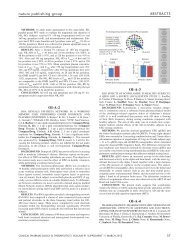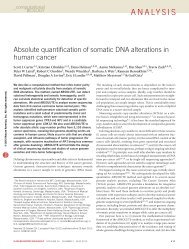open access: Nature Reviews: Key Advances in Medicine
open access: Nature Reviews: Key Advances in Medicine
open access: Nature Reviews: Key Advances in Medicine
Create successful ePaper yourself
Turn your PDF publications into a flip-book with our unique Google optimized e-Paper software.
NEUROLOGY<br />
In summary, research <strong>in</strong> 2011 conveyed<br />
new f<strong>in</strong>d<strong>in</strong>gs to help us to understand, treat<br />
and prevent disease progression <strong>in</strong> patients<br />
with MS. Better imag<strong>in</strong>g of cortical lesions<br />
could provide <strong>in</strong>sights <strong>in</strong>to the patho biology<br />
of MS and may yield new outcome measures<br />
for MS cl<strong>in</strong>ical trials. <strong>Advances</strong> <strong>in</strong> understand<strong>in</strong>g<br />
the environmental factors that are<br />
associated with disease progression <strong>in</strong> MS<br />
could facilitate the development of better<br />
therapies and personalized management for<br />
patients with this disabl<strong>in</strong>g disease.<br />
Jacobs Neurological Institute, Buffalo General<br />
Hospital, University at Buffalo, State University<br />
of New York, Build<strong>in</strong>g E, 2nd Floor, 100 High<br />
Street, Buffalo, NY 14203, USA<br />
(B. We<strong>in</strong>stock‑Guttman). Department of<br />
Pharmaceutical Sciences and Neurology, State<br />
University of New York, 427 Cooke Hall, Buffalo,<br />
NY 14260, USA (M. Ramanathan).<br />
Correspondence to: B. We<strong>in</strong>stock–Guttman<br />
bguttman@thejni.org<br />
Acknowledgments<br />
The authors would like to thank the Department of<br />
Defense, the Jog for The Jake Foundation, National<br />
Multiple Sclerosis Society, National Science<br />
Foundation and NIH for provid<strong>in</strong>g f<strong>in</strong>ancial support<br />
for their research activities.<br />
Compet<strong>in</strong>g <strong>in</strong>terests<br />
B. We<strong>in</strong>stock–Guttman declares associations with<br />
the follow<strong>in</strong>g companies and organizations: Acorda,<br />
Biogen Idec, Cyberonics, EMD Serono, Novartis,<br />
Pfizer, Teva Neuroscience. M. Ramanathan declares<br />
associations with the follow<strong>in</strong>g companies and<br />
organizations: Allergan, the American Association of<br />
Pharmaceutical Scientists, Biogen Idec, EMD<br />
Serono, Netezza, Novartis, Pfizer. See the article<br />
onl<strong>in</strong>e for full details of the relationships.<br />
1. O’Connor, P. et al. Randomized trial of oral<br />
teriflunomide for relaps<strong>in</strong>g multiple sclerosis.<br />
N. Engl. J. Med. 365, 1293–1303 (2011).<br />
2. Sormani, M. P. et al. Model<strong>in</strong>g the distribution<br />
of new MRI cortical lesions <strong>in</strong> multiple<br />
sclerosis longitud<strong>in</strong>al studies. PLoS ONE 6,<br />
e26712 (2011).<br />
3. We<strong>in</strong>stock‑Guttman, B. et al. Serum lipid<br />
profiles are associated with disability<br />
and MRI outcomes <strong>in</strong> multiple sclerosis.<br />
J. Neuro<strong>in</strong>flammation 8, 127 (2011).<br />
4. We<strong>in</strong>stock‑Guttman, B., Zivad<strong>in</strong>ov, R. &<br />
Ramanathan, M. Inter‑dependence of vitam<strong>in</strong><br />
D levels with serum lipid profiles <strong>in</strong> multiple<br />
sclerosis. J. Neurol. Sci. 311, 86–91 (2011).<br />
5. Kappos, L. et al. A placebo‑controlled trial of<br />
oral f<strong>in</strong>golimod <strong>in</strong> relaps<strong>in</strong>g multiple<br />
sclerosis. N. Engl. J. Med. 362, 387–401<br />
(2010).<br />
6. Calabrese, M., Filippi, M. & Gallo, P. Cortical<br />
lesions <strong>in</strong> multiple sclerosis. Nat. Rev. Neurol.<br />
6, 438–444 (2010).<br />
DEMENTIA IN 2011<br />
Microbleeds <strong>in</strong> dementia<br />
—s<strong>in</strong>g<strong>in</strong>g a different ARIA<br />
Philip Scheltens and Jeroen D. C. Goos<br />
In 2011, researchers used imag<strong>in</strong>g techniques to <strong>in</strong>vestigate<br />
bra<strong>in</strong> microbleeds <strong>in</strong> patients with dementia and highlighted how lobar<br />
microbleeds could be used as a marker for amyloid pathology and for<br />
predict<strong>in</strong>g mortality. New guidel<strong>in</strong>es on the <strong>in</strong>clusion and exclusion<br />
of participants with microbleeds <strong>in</strong> anti-amyloid cl<strong>in</strong>ical trials were<br />
also published.<br />
Scheltens, P. & Goos, J. D. C. Nat. Rev. Neurol. 8, 68–70 (2012); published onl<strong>in</strong>e 10 January 2012;<br />
doi:10.1038/nrneurol.2011.222<br />
Follow<strong>in</strong>g <strong>in</strong>itial reports of small dotlike<br />
lesions on gradient-echo MRI <strong>in</strong> the<br />
bra<strong>in</strong>s of patients with dementia (Figure 1),<br />
many <strong>in</strong>vestigators set out to describe<br />
the prevalence and <strong>in</strong>cidence of these<br />
lesions—later designated as micro bleeds<br />
or microhemorrhages—<strong>in</strong> both healthy<br />
people and <strong>in</strong>dividuals with this condition.<br />
Prevalence rates varied from 10% <strong>in</strong> healthy<br />
elderly <strong>in</strong>dividuals to 60% <strong>in</strong> patients with<br />
vascular dementia. 1 Interest <strong>in</strong> these lesions<br />
peaked when the first cases of <strong>in</strong>cident<br />
micro bleeds along with <strong>in</strong>creased signal<br />
<strong>in</strong>ten sity on fluid-attenuated <strong>in</strong>version recovery<br />
imag<strong>in</strong>g, thought to represent vaso genic<br />
edema, were reported <strong>in</strong> patients receiv<strong>in</strong>g<br />
amyloid-lower<strong>in</strong>g therapy. Dur<strong>in</strong>g the 2010<br />
Inter national Conference on Alzheimer<br />
Disease (AD), turmoil ensued over a cautionary<br />
letter from the FDA, which suggested<br />
drastic cut-offs <strong>in</strong> randomized cl<strong>in</strong>ical trials<br />
of amyloid-lower<strong>in</strong>g drugs, both <strong>in</strong> terms of<br />
exclud<strong>in</strong>g patients with a s<strong>in</strong>gle microbleed<br />
and term<strong>in</strong>at<strong>in</strong>g the participation of patients<br />
who developed a new microbleed dur<strong>in</strong>g<br />
the study. In response, a series of important<br />
papers regard<strong>in</strong>g the detection, prevalence<br />
and cl<strong>in</strong>ical relevance of microbleeds<br />
<strong>in</strong> patients with dementia-related disease<br />
appeared <strong>in</strong> 2011, <strong>in</strong>clud <strong>in</strong>g a consensus<br />
statement from an <strong>in</strong>ter national work<strong>in</strong>g<br />
group that <strong>in</strong>troduced new term<strong>in</strong>ology.<br />
At the beg<strong>in</strong>n<strong>in</strong>g of 2011, Cordonnier<br />
and van der Flier reviewed the available<br />
litera ture on bra<strong>in</strong> microbleeds <strong>in</strong> patients<br />
with AD. 1 The authors suggested that<br />
these lesions were associated with amyloid<br />
pathology and may have a crucial role <strong>in</strong> the<br />
pathophysiology of AD. Microbleeds were<br />
proposed to represent a l<strong>in</strong>k between the<br />
amyloid cascade hypo thesis and the vascular<br />
hypothesis—both popular explanatory<br />
models for the pathogenesis of AD. Furthermore,<br />
the location of the microbleeds was<br />
suggested to <strong>in</strong>dicate their underly<strong>in</strong>g etiology:<br />
lobar microbleeds would presumably<br />
be associated with cerebral amyloid angiopathy<br />
(CAA), whereas microbleeds <strong>in</strong> deep<br />
bra<strong>in</strong> regions would be associated with<br />
hypertensive vasculopathy and <strong>in</strong>creased<br />
risk of vascular complications. The cl<strong>in</strong>ical<br />
implications of microbleeds <strong>in</strong> patients<br />
with dementia were also stressed. Besides<br />
an association with cognition, micro bleeds<br />
have been l<strong>in</strong>ked to mortality, especially <strong>in</strong><br />
cases of multiple lesions, as described by<br />
Henneman et al. <strong>in</strong> a 2009 study. 2 These<br />
<strong>in</strong>vestigators did not, however, assess the<br />
cause of death <strong>in</strong> their patients.<br />
Throughout 2011—with<strong>in</strong> months of<br />
publication of the review by Cordonnier<br />
and van der Flier 1 —reports were published<br />
on several studies that have substantially<br />
extended our knowledge on microbleeds<br />
<strong>in</strong> patients with dementia-associated diseases.<br />
The suggestion that micro bleeds<br />
were closely l<strong>in</strong>ked to amyloid pathology<br />
was supported by the f<strong>in</strong>d<strong>in</strong>gs of Yates et al.<br />
for the Australian Imag<strong>in</strong>g, Bio markers<br />
and Lifestyle Study of Age<strong>in</strong>g Research<br />
Group. 3 They found that even <strong>in</strong> healthy<br />
con trols, lobar microbleeds (detected us<strong>in</strong>g<br />
3T susceptibility-weighted imag<strong>in</strong>g [SWI])<br />
were associated with higher amyloid burden,<br />
as seen on 11 C-Pittsburgh compound B (PiB)<br />
PET imag<strong>in</strong>g. Moreover, PiB-positive scans<br />
were more prevalent <strong>in</strong> participants with<br />
multiple lobar microbleeds (86%) than<br />
<strong>in</strong> those with only one lobar microbleed<br />
(67%). In agreement with these f<strong>in</strong>d<strong>in</strong>gs,<br />
results from a study by Goos et al., 4 <strong>in</strong> which<br />
cerebro sp<strong>in</strong>al fluid amyloid biomarkers were<br />
used to assess amyloid burden, confirmed<br />
the relationship between lobar microbleeds<br />
and amyloid pathology.<br />
Altmann–Schneider and colleagues<br />
studied the relationship between microbleeds<br />
and mortality (with assessment of<br />
the cause of death) <strong>in</strong> a population of 435<br />
elderly people with pre-exist<strong>in</strong>g vascular<br />
dis ease. 5 Individuals with more than one<br />
microbleed had a sixfold <strong>in</strong>crease <strong>in</strong> the risk<br />
S60 | JANUARY 2012 www.nature.com/reviews








